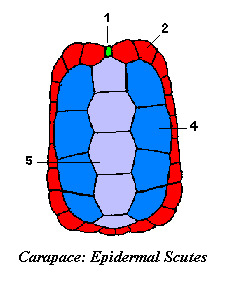

| Chelonii | ||
| The Vertebrates | Testudines |
| Vertebrates Home | Vertebrate | Vertebrate |
|
Abbreviated Dendrogram
Anapsida ?
│
└─○Chelonii
├─Odontochelys
└─○Testudinata
├─Proganochelys
├─Chinlechelys
└─○Casichelydia
└─┬─Proterochersis
├─Kayentachelys
└─┬─Meiolanoidea
└─┬─Pleurodira
├─Paracryptodira
└─○Eucryptodira
├─Protostegidae
╘═╤═Xinjiangchelyidae
╞═Sinemydidae
├─Trionychoidea
└─┬─┬─Chelonioidea
│ ├─Chelydridae
│ └─Kinosternoidea
└─Testudinoidea
|
Contents
Overview |
Taxa on This Page
 |
 |
||
| 1 | Cervical (1) | 1 | Nuchal (1) |
| 2 | Marginals (12L+12R) | 2 | Peripheral (11L+11R) |
| 4 | Pleurals (4L+4R) | 3 | Neural (8) |
| 5 | Vertebral (5) | 4 | Costal (8L+8R) |
| 6 | Pygal (1) | ||
| 7 | Suprapygal (1) | ||
Fortunately, this loss to Chelonian liberty is partially offset by the public availability of a certain amount of zoological information. Turtle shells are constructed with a layer of epidermal scutes overlying a layer of dermal bone. Pursuant to § 820.112.41(1), the FVO has decreed that the scutes of all turtle carapaces (dorsal shells) shall have the form shown in the figure at right.
The names have been changed to protect the innocent and, more to the point, to reflect the generally accepted names of the scutes. Unfortunately, the original regulations confuse the names of the epidermal scutes (shown here) with the names of the underlying dermal bones. The bones do not conform to the same pattern and have rather different names. The marginal scutes are numbered from the cervical, in both directions, so that the marginal immediately to the left of the cervical, for example, is the First Left Marginal. The scute numbered "2" is thus the Second Right Marginal. Similarly, the scute labelled "4" is the Second Right Pleural and "5" points to the Third Vertebral. This pattern, like the pattern of the dermal bones and the pattern of the scutes and bones of the plastron (ventral shell) is remarkably consistent across all turtles, paticularly extant forms.
The underlying dermal bones are shown in the right half of the figure. These are numbered in the same fashion as the scutes. The first four pairs of costals each fuse with a pair of ribs.
 |
|||
| 1 | Gular | 1 | Epiplastron |
| 2 | Humeral | 2 | Entoplastron |
| 3 | Axillary | 3 | Hyoplastron |
| 4 | Pectoral | 4 | Hypoplastron |
| 5 | Abdominal | 5 | Xiphiplastron |
| 6 | Inguinal | ||
| 7 | Femoral | ||
| 8 | Anal | ||
What is perhaps most extraordinary about this arrangement is that turtles have maintained this particular dual structure for well over 100 My -- even without regulatory supervision under the ever-vigilant eyes of the Federal Veterinary Office. There appears to be no satisfactory explanation for the remarkable stability of this particular arrangement. Bear in mind that turtles inhabit an extraordinary number of different environments and have developed some impressive adaptations. Thus for example, the pleurodire Rheodytes has evolved the ability to breath through its cloaca, a talent rarely found except among politicians. Yet, something as apparently trivial as the pattern of epidermal scutes has remained almost completely unaffected from the Triassic Proganochelys to the present day.
Either this arrangement has some unknown, but obviously critical, functional significance, or we are missing an important point about evolution. Of all the many fundamental unanswered questions in vertebrate paleontology, one of the most strange and difficult is the mundane constancy of turtle shells. ATW
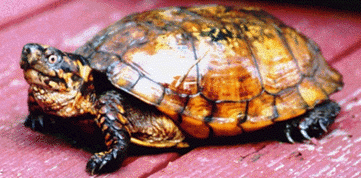 Testudines : turtles, tortoises, and their kin
Testudines : turtles, tortoises, and their kin
from the Triassic.
Chelonii : Odontochelys + * : Proganochelys + Chinlechelys + Casichelydia
Characters: For testudines above the Odontochelys grade: completion of CR, Dermal carapace, Fan-shaped ribs, Encapsulation of scapula (ref fig 3); Original definition: Double shell (carapace & plastron) with dermal scutes. Beak covers maxilla, premaxilla & dentary. Retracted neck in K; otic capsule enlarged & jaw adductor passes over this or trochlear process of pterygoid, giving more vertical pull on lower jaw; carapace with 59 dermal bones, 8 fused to neural arches, 8 pairs fused to widened ribs; ribs external to girdles; plastron dermal bone plus clavicles & interclavicals; shell kinesis in some species; ATW
Notes: [1] Mesozoic forms, even in the Cretaceous, apparently had shell fontanelles, less remodeling of ribs, and underdeveloped shell elements compared to modern forms. ATW030422
[2] Many workers prefer "Chelonia" for the stem group, reserving "Testudines" for the crown group (LCA extant turtles). For various reasons, the traditional nomenclature is used here. Gaffney, 1975 coined Casichelyidia for Pleurodires and Cryptodires, but this does not seem to have caught on among more recent workers, who use Testudinata for the stem group and Testudines for the crown group. "Pantestudines" [1] is an alternative term for the stem group (turtles > crocs, lizards, etc), equivalent to Chelonii as here defined. For the sake of convenience, Testudines or Testudinata is here informerly used for all chelonii with a developed carapace (unless secondarily reduced in aquatic or marine forms) and toothless beak ATW, MAK121222
Note: In cladistics, distinguishing between crown group taxa and the group as a whole has led to some confusion, e.g. Crown Group Tetrapods become Tetrapods, Crown Group Testudines (the group that includes the common ancestor of all extant testudines and its descendents, are just called Testudines, and so on. One way around this has been to append the prefix Pan- (Meaning "all") to the more inclusive non-crown clade, e.g. Pantestudines (Joyce et al 2004)
back
Image: from Herp Pictures - Turtles (former site) by permission.
Links: Higher Reptile Taxa; Turtle and Tortoise Ring (with 224 sites at last count!); Introduction to Testudines; Animal Diversity Web: Order Testudines; Testudines Turtle Skull Reproductions; Higher Relationships of Testudines; Order Testudines (Czech & English); Tortoise Trust Web - Start Page; Willkommen beim Reptilien Projekt (German & English); Turtles and Tortoises; The Center for North American Herpetology - Web Portal; Testudines Tree of Life); Testudines Turtle Skull Reproductions great collection of skull casts); Georgia Wildlife Web Site; reptiles- testudines nice summary of diversity); Testudines Spanish); APUS.RU | ????? ·???????? - Testudines Russian); Testudines_100085_1.htm">NatureServe Explorer Species Index- Order Testudines; BiologyBrowser links); Testudines (turtles, tortoises) South African turtles); Link to NCBI Front Page; The EMYSSystem (Best on the Web); Testudines; Order Testudines. ATW030422 Animal Diversity Web: Testudines.
References: Gauthier et al. (1988); Lee (1996); Rieppel 1995); Shaffer et al. (1997). ATW030422.
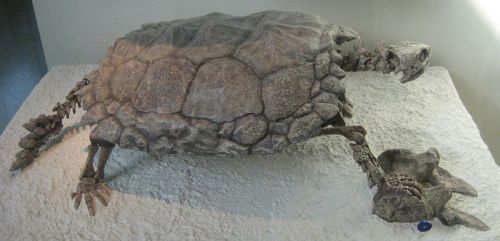
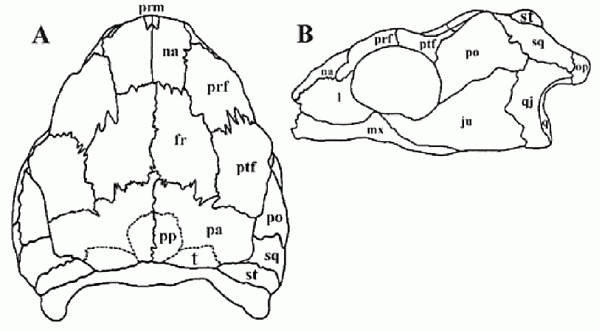 Skull of Proganochelys quenstedti Baur 1887. After Kordikova 2002, url). Dorsal (A) and ventral (B) views. Abbreviations: ju - jugal, l - lacrimal, mx - maxilla, na - nasal, pa – parietal, po - postorbital, prf - prefrontal, prm - premaxilla, ptf - postfrontal, pt - pterygoideum, q - quadrate, qj - quadratojugal, sq - squamosal, st - supratemporal, t - tabular. |
Late Triassic of Europe (P. quenstedtii), related forms in SE Asia (Thailand) & NAm.
Synonyms: Chelytherium, Psammochelys, Stegochelys, Triassochelys.
Testudinata : Casichelydia + Chinlechelys + *.
 Characters: turtle skull and beak; but denticles on vomer, palatine and pterygoid; maxilla, premaxilla, and dentary edentulous; vomers paired (primitive); interpterygoid vacuity present; moveable basipterygoid articulation (primitive); nasals paired; lacrimal small, but present, with lacrimal duct (primitive); supratemporal present (primitive); expanded posttemporal fenestra (allows jaw muscles to become longer and stronger -- muscle origin on occiput); quadrate concave posteriorly and exposed laterally on cheek; postparietals and postfrontals absent; stapes solid, rodlike, without foramen or processes; middle ear without bony lateral wall (primitive); $ paroccipital process of opisthotic attached to braincase only at its distal end primitive); paroccipital process only loosely attached to squamosal (note: this is slightly inconsistent with previous character); squamosal & postorbital tightly sutured; cervical vertebrae not specialized; 10 trunk vertebrae; 10th trunk vertebra not in sacrum; $ tail club (? or at least osteoscutes on tail); fully developed bony shell consisting of a carapace (formed from costal bones with fused ribs, neural bones with fused thoracic vertebrae, and marginal bones), a plastron (formed from interclavicle, clavicle, and five paired bones sutured together); carapace and plastron enclosing shoulder girdle and pelvic girdle; cleithrum absent; gracile scapulocoracoids and pelvic girdle; pelvic girdle not fused to carapace; $ phalangeal formula (manus and pes) of 2-2-2-2-2 (maybe 2 digits with 3 phalanges on manus?); fresh water habitat, but not exclusively aquatic.
Characters: turtle skull and beak; but denticles on vomer, palatine and pterygoid; maxilla, premaxilla, and dentary edentulous; vomers paired (primitive); interpterygoid vacuity present; moveable basipterygoid articulation (primitive); nasals paired; lacrimal small, but present, with lacrimal duct (primitive); supratemporal present (primitive); expanded posttemporal fenestra (allows jaw muscles to become longer and stronger -- muscle origin on occiput); quadrate concave posteriorly and exposed laterally on cheek; postparietals and postfrontals absent; stapes solid, rodlike, without foramen or processes; middle ear without bony lateral wall (primitive); $ paroccipital process of opisthotic attached to braincase only at its distal end primitive); paroccipital process only loosely attached to squamosal (note: this is slightly inconsistent with previous character); squamosal & postorbital tightly sutured; cervical vertebrae not specialized; 10 trunk vertebrae; 10th trunk vertebra not in sacrum; $ tail club (? or at least osteoscutes on tail); fully developed bony shell consisting of a carapace (formed from costal bones with fused ribs, neural bones with fused thoracic vertebrae, and marginal bones), a plastron (formed from interclavicle, clavicle, and five paired bones sutured together); carapace and plastron enclosing shoulder girdle and pelvic girdle; cleithrum absent; gracile scapulocoracoids and pelvic girdle; pelvic girdle not fused to carapace; $ phalangeal formula (manus and pes) of 2-2-2-2-2 (maybe 2 digits with 3 phalanges on manus?); fresh water habitat, but not exclusively aquatic.
Comments: A common animal from the German Keuper (mid Norian). Attained a length of 60 cm. In contrast to Odontochelys, the plates had already fully formed. there were also smaller marginal plates. The contemporary Chinlechelys tenertesta is more primitive in certain respects (and more advanced in others), with a much thinner shell. MAK100520
Links: Proganochelys Best on the Web); Chelonian Ancestry; Anapsida: Life History and Ecology; Phylogeny and Classification of Amniotes (figs 1D, 2D, & 3D are Proganochelys); Molecular Evidence for Higher Relationships Among Turtles; Biology 356; tortugas.html Spanish); qui (French -- with homemade Bach-omorph fugue & variations!); Turtle Origins; The Paleo Art of D.W. Miller; Turtle.htm; Proganochelys; American Museum of Natural History: Proganochelys; turtle; Paleontology and Geology Glossary: Pr; I. ¿Qué tan viejas son las tortugas? (Spanish). ATW010606. Wikipedia
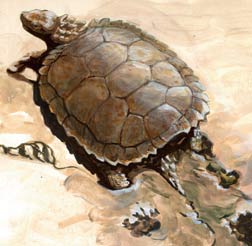 Chinlechelys C. tenertesta Joyce, et. al. 2008
Chinlechelys C. tenertesta Joyce, et. al. 2008
Late Triassic Revueltian: Mid Norian), Chinle Group of New Mexico
Testudinata : Casichelydia + Proganochelys + *).
Characters: very thin (1 to 3mm) shell (hence the name: "delicate shelled turtle from the Chinle"), neck spines formed by multiple osteoderms, ribs only loosly fused to carapace (upper shell). Terrestrial habits.
Graphic: Life restoration by Mary Sundstrom, from HMNH
|
oTestudines
├─Chinlechelys
├─Proganochelys
└─┬─Palaeochersis
├─Australochelys
└─┬─Proterochersis
└─┬─Kayentachelys
└─┬─Mongolochelys
└─Testudines crown group |
After Joyce, Lucas, Scheyer, Heckert & Hunt, 2009 (from Mikko's Phylogeny Archive) |
Comments: Joyce, et. al. 2008 argue (on the basis of Chinlechelys) that testudines evolved from terrestrial forms, and that dermal ossifications (armor plating) in the skin evolved independently from and fused and integrated with the costal bones, (ribs and vertebrae), which would seem to support the parierasaur origin hypothesis. But this is refuted by the discovery the following year of Odontochelys, a more primative marine form with a fully-developed plastron (lower shell) but no carpace (upper shell). Reisz & Head 2008 argue that Odontochelys descended from carpaced ancestors, but lost the dermal ossifications secondarily after moving into the sea. like leatherbacks and soft-shelled turtles. (A Carpaceless Turtle link/link(mirror postings))
References: Joyce, et. al. 2008
Links: Hairy Museum of Natural History, Chinleana, Palaeblog MAK100520
checked ATW040118, page MAK100520. Page last modified MAK121222.
All material by ATW is public domain and may be freely used in any way (also any material jointly written by ATW and MAK). All material by MAK is licensed Creative Commons Attribution License Version 3.0, and may be freely used provided acknowedgement is given. All Wikipedia material is either Gnu Open Source or Creative Commons (see original Wikipedia page for details). Other graphics are copyright their respective owners